文章信息
- 朱龙海, 张自豪, 刘志杰, 徐永臣, 王楠, 苗晓明. 2018.
- ZHU Long-hai, ZHANG Zi-hao, LIU Zhi-jie, XU Yong-chen, WANG Nan, MIAO Xiao-ming. 2018.
- 山东半岛东部海域表层沉积物微量元素分布及物源指示意义
- The distribution of trace elements of the surface sediments in the eastern Shandong Peninsula and its indication significance
- 海洋科学, 42(5): 1-11
- Marine Sciences, 42(5): 1-11.
- http://dx.doi.org/10.11759/hykx20180326002
-
文章历史
- 收稿日期:2018-03-26
- 修回日期:2018-04-23
2. 中国海洋大学 海底科学与探测技术教育部重点实验室, 山东 青岛 266100;
3. 国家海洋信息中心, 天津 300171;
4. 中国海洋大学, 山东 青岛 266100
2. Key Lab of Submarine Geosciences and Prospecting Techniques, Ocean University of China, Qingdao 266100, China;
3. National Marine Information Center, Tianjin 300171, China;
4. Ocean University of China, Qingdao 266100, China
近年来, 陆架边缘海的“源-汇”过程已成为边缘海沉积研究的热点, 海洋沉积从源到汇的机制也成为研究海洋沉积作用的核心问题[1-7]。黄海作为一个独特的半封闭式边缘海, 位于我国大陆和朝鲜半岛之间[8-9], 每年接纳大量的周边河流入海物质, 包括我国的长江、黄河和韩国河流, 沉积物源多种多样[1-2], 形成一个巨大的“汇”。黄河每年携带约为1.1×109 t的泥沙入海[4], 这些沉积物在冬季强海洋动力下经沿岸流搬运, 绕过成山头向南输送, 进入南黄海[5-6]。而南黄海沉积物同时受到北上黄海暖流、沿岸流以及近岸潮流的影响, 分布差异大[9]。众多学者在南黄海开展了一系列表层沉积物物源示踪的研究[1, 7, 10-17], 并取得了大量的成果。蓝先洪等[10-12, 16]对南黄海沉积物的物源和运移进行了探讨, 认为南黄海中、西部主要物质来源为黄河输送的物质, 但也可能会有黄海暖流带来的物质[16], 且Sr、Co元素可以用来区分黄河、长江和韩国河流物质来源[12]。李国刚等[7]通过对山东半岛沿岸海域表层沉积物中常量元素地球化学特征的分析, 认为山东半岛沿岸海域主要为黄河源沉积物。窦衍光等[15]根据常微量元素分析认为, 山东半岛近岸及东南部海域沉积物以黄河源物质为主, 并受到山东半岛沿岸流和近岸潮流的影响。
众多学者运用粒度、稀土元素、常量元素、黏土矿物等[1, 7, 10-20]测试结果对南黄海的沉积特征和物质来源开展了一系列研究, 但对于微量元素的研究较少, 且不同的研究方法得出结果存在一定的差异。本文研究目的是通过微量元素分析测试结果, 结合聚类分析和因子分析方法, 探讨南黄海西北部、山东半岛东部海域表层沉积物的物源和控制因素。本文成果对于进一步补充和完善山东半岛泥质区的物质来源和沉积物输运过程研究具有重要意义。
1 研究区背景与材料方法研究区位于南黄海西北部、山东半岛东部近岸海域, 构造上处于山东胶北断块隆起的东端, 属于温带季风气候, 四季分明。研究区内入海河流均为季节性短源河流, 对研究区的影响可以忽略。而研究区所处的南黄海沉积动力条件比较复杂[21], 环流具有典型的季节特征[3], 其中环流包括北上的黄海暖流和南下的沿岸流, 黄海暖流是北上的黑潮的一个分支, 主轴位于123°E附近的黄海槽西侧[22]。
本文所用样品为2006年“我国近海海洋综合调查与评价”专项在山东半岛东部近岸海域取得的79个表层沉积物样品, 样品采用蚌式取样器获取, 取样站位分布如图 1所示。对所获得的表层沉积物样品在实验室进行粒度和地球化学测试分析。
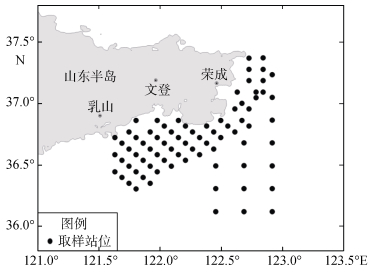 |
| 图 1 研究区取样站位分布图 Fig. 1 Sampling stations in the study area |
粒度测试使用英国产Malvern Mastersizer 2000型激光粒度仪, 测量范围为0.02~2 000 μm。用30%的过氧化氢和0.25 mol/L的盐酸除去样品中的有机质及钙质胶结物和生物壳体(CaCO3), 采用静法洗盐, 将样品溶液调为中性, 滴入数滴0.5 mol/L的六偏磷酸钠, 用超声波震荡使样品分散, 然后上机测试。重复测试的相对误差小于3%。
在进行微量元素测试时, 将沉积物冷冻干燥后, 研磨至200目, 并用烘箱烘干, 称取0.05 g样品置于聚四氟乙烯消解罐, 加入2次蒸馏过的氢氟酸和硝酸(1︰1)对沉积物进行消解, 置于烘箱190℃保持48 h, 冷却后置于电热板上蒸干, 加入3 mL 50%的HNO3, 置于烘箱150℃继续溶样8 h以上, 移液后定容待测, 用ICP-OES(Ba、Sr、V、Zn、Zr)和ICP-MS (Cr、Co、Ni、Cu)对沉积物样品中的元素进行分析测试。为了监控测试精度和准确度, 分别进行了若干样品的重复分析与标样(GSD-9)分析, 结果表明分析元素的相对误差小于2%。
2 结果 2.1 表层沉积物分布特征根据Folk分类[24]可以得出沉积物类型主要包括粉砂、泥和砂质粉砂, 另外在研究区中东部有一个站位为砾质砂, 东北部有一个站位为砾质泥质砂(如图 2所示)。从空间分布来看, 近岸海域粒度相对较粗, 主要为砂质粉砂和粉砂, 离岸较远的区域粒度相对较细, 以粉砂和泥为主, 研究区东南部粒度最细。
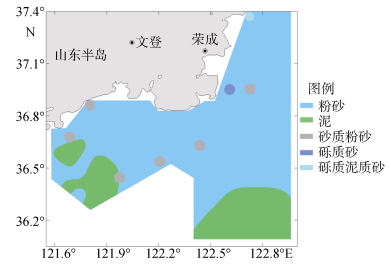 |
| 图 2 研究区表层沉积物类型分布图 Fig. 2 Distribution map of the surface sediment types in the study area |
研究区表层沉积物中主要的粒级组分是粉砂, 组分百分比约为70.73%, 其次为黏土和砂, 约为24.75%和3.93%。研究区砂质组分总体较低, 在东北部有两个高值区, 可能是沿岸侵蚀造成的。粉砂组分是研究区表层沉积物最主要的粒度组分, 总体上表现出中部含量高、东北部沿岸和南部含量低的特征。黏土组分呈现南高北低的特征, 在东南部含量最高。平均粒径(Φ)最小为1.55, 最大为7.72, 大部分Φ介于5~7.5, 如图 3所示。
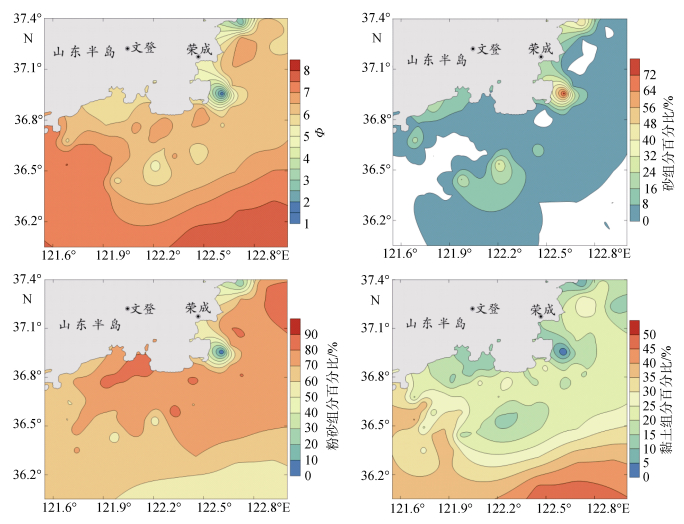 |
| 图 3 研究区表层沉积物特征分布图 Fig. 3 Distribution map of the surface sediment features in the study area |
研究区表层沉积物中各微量元素含量分布不均匀, 含量变化波动较大; 除Ba、Zr元素变异系数小于0.15外, 其余微量元素变异系数均大于0.15, 如表 1所示。研究区周边河流表层沉积物微量元素质量比如表 2所示。
| 元素 | 元素质量比/(μg/g) | 变异系数 | ||
| 最小值 | 最大值 | 平均值 | ||
| Cr | 35 | 100 | 60 | 0.20 |
| Cu | 12 | 40 | 21 | 0.30 |
| Pb | 19 | 42 | 27 | 0.15 |
| Zn | 37 | 181 | 81 | 0.38 |
| Ba | 401 | 782 | 465 | 0.13 |
| Sr | 137 | 447 | 198 | 0.18 |
| Zr | 46 | 119 | 91 | 0.13 |
| V | 44 | 138 | 83 | 0.22 |
| Co | 9 | 24 | 17 | 0.18 |
| Ni | 19 | 57 | 33 | 0.23 |
| 元素 | 元素质量比/(μg/g) | |||||||||||||||
| 长江[25-29] | 黄河[27-30] | 锦江[31] | 荣山江[25, 31] | |||||||||||||
| Cr | 77.9 | 83 | 99.55 | 77.95 | 74.25 | 64.2 | 72 | 60 | 66.93 | 64.77 | 99 | 52.4 | 51.96 | |||
| Cu | 47.6 | 69.5 | 40.28 | 47.56 | 50.67 | 17.6 | 33 | 13 | 17.05 | 17.8 | 55 | 39.1 | 20.38 | |||
| Pb | 50.5 | 64.5 | 49.9 | 50.49 | 38.49 | 29.2 | — | 15 | 29.23 | 29.49 | 79 | 35 | 26.82 | |||
| Zn | — | — | 107.9 | 116.2 | 106.5 | — | — | — | 59.22 | 60.33 | — | — | 76.61 | |||
| Ba | 461 | 560 | 691 | 461.2 | 473 | 643 | 600 | 540 | 678 | 663.2 | 570 | 604 | 385 | |||
| Sr | 136 | 150 | 128.1 | 135.5 | 147 | 188 | 220 | 220 | 186 | 186.6 | 117 | 111 | 119 | |||
| Zr | — | — | 204 | 258.3 | 161 | — | — | — | 266.8 | 262.5 | — | — | 142 | |||
| V | 141 | 160 | 168.4 | 140.5 | 106 | 105 | 110 | 60 | 108.3 | 108.9 | 97 | 94 | 86.7 | |||
| Co | 15.1 | 24.5 | 15.76 | 15.14 | 17.27 | 11 | 12 | 9 | 11.38 | 10.98 | 19 | 17.7 | 15.7 | |||
| Ni | 40.9 | 78 | 40.04 | 40.93 | 40.7 | 26.3 | 38 | 20 | 25.79 | 26.71 | 56 | 32.7 | 32.77 | |||
| 注: “—”表示没有数据。 | ||||||||||||||||
研究区表层沉积物10种微量元素中, Ba总体含量最高, Co含量最低; 各微量元素含量由高到低的次序依次为Ba、Sr、Zr、V、Zn、Cr、Ni、Pb、Cu、Co, 研究区表层沉积物微量元素含量空间分布如图 4所示(m表示元素质量比, μg/g)。Ba元素含量整体呈中间低, 四周高的趋势, 研究区北部出现3个高值区, 最大值达782 μg/g。Sr平均质量比198 μg/g, 在研究区中部和东北部偏高, 质量比大于188 μg/g, 整体上呈北东南西向分布。Cr、Cu、Ni、Pb、Co和V平均质量比分别为60、21、33、27、17、83 μg/g, 在空间上除局部区域出现低值外, 整体分布特征相似, 在南部粒径较细的沉积物中含量偏高, 在东南部区域含量最高, 在中部和东北部靠岸地区含量较低。Zr质量比为46~119 μg/g, 在东北部靠岸地区最低, 在东部和东南部区域偏高, 最高值在东南部。Zn质量比为37~181 μg/g, 在中部偏南区域出现三个高值区, 研究区北部整体含量较低, 最低值在东北部靠岸区域。
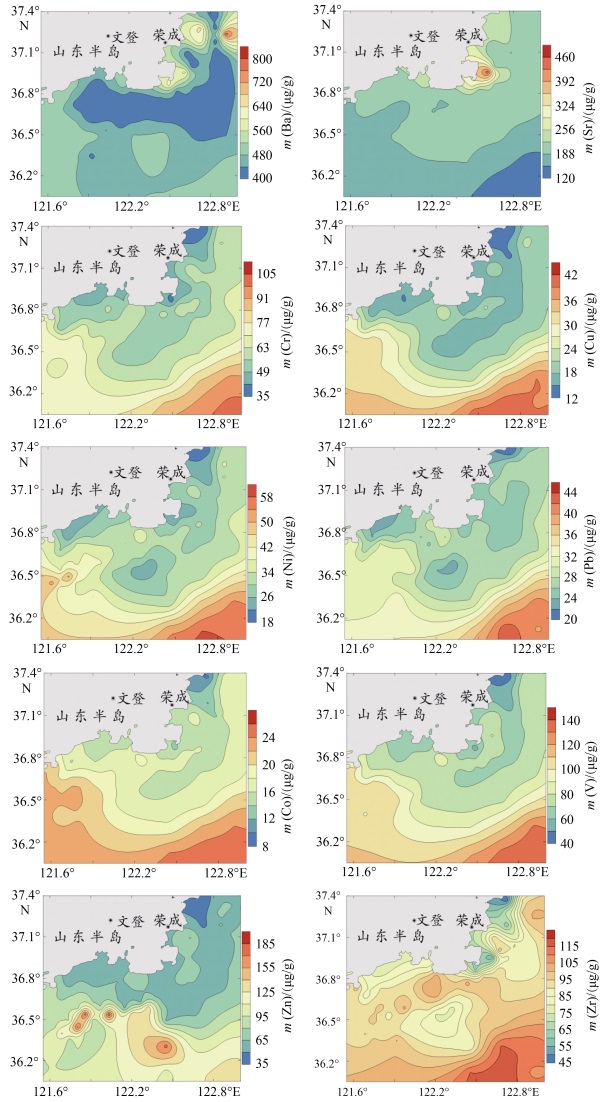 |
| 图 4 研究区表层沉积物微量元素含量空间分布 Fig. 4 The spatial distribution of trace elements of the surface sediments in the study area |
为了探讨研究区微量元素的含量在空间上的差异性, 将79个表层沉积物的微量元素含量作为变量, 进行Q型聚类分析。聚类分析结果可将其分为两个区(图 5), Ⅰ区位于研究区的东南和西南部海域, Ⅱ区位于研究区的中部和东北部海域, 两个分区大致以36.5°N南北分界。Ⅰ区主要富集Zn、V、Co、Cr、Cu、Ni、Pb、Zr和Ba, Ⅱ区明显富集Sr。
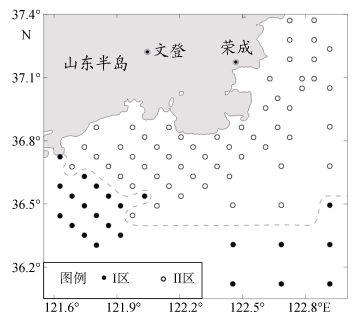 |
| 图 5 研究区表层沉积物微量元素系统聚类分析 Fig. 5 The system clustering analysis of trace elements of the surface sediments in the study area |
研究区位于南黄海中部泥质区西北侧, 南黄海中部泥质区分布范围为33.48°~36.68°N、121.70°~ 124.56°E[32], 研究区东南侧和泥质区紧邻。已有研究表明南黄海中部泥质区沉积主要受逆时针旋转的气旋型涡旋即冷涡的控制, 同时也受到上升流的影响[3, 32], 但南黄海中部泥质体必须是北上的黄海暖流与向南流动的黄海沿岸流相互作用, 在冷涡的控制下才能形成[33]。
李国刚等[7]研究表明黄河来源沉积物经沿岸流搬运绕过山东半岛后, 流速减弱, 又受到黄海暖流的阻挡作用, 所以在36.5°N附近向西偏转后快速沉积大量的沉积物。向北流动的黄海暖流在北上途中与周围水体混合交换, 会携带部分南黄海物质[34], 而南黄海的主要物源之一又是长江物质。因此本文考虑黄海暖流向北阻挡黄海沿岸流后发生相互混合, 可能会导致黄海暖流携带的南黄海物质随沿岸流一起向西运移扩散。
3.2 物源对微量元素含量的影响海底沉积物组成受沉积环境和物质来源的影响[35-36], 为充分了解研究区微量元素的控制因素, 对研究区79个站位的10种微量元素及其平均粒径进行了R型因子分析, 结果如表 3所示。分析得到了2个因子, 累积解释了全部信息的81.02% (如表 3所示), 能够较好的说明研究区内微量元素控制因素的情况。
| 元素 | 成分矩阵载荷 | |
| 因子1 | 因子2 | |
| Cr | 0.92 | 0.26 |
| Cu | 0.97 | 0.14 |
| Pb | 0.92 | 0.18 |
| Zn | 0.68 | –0.07 |
| Ba | 0.24 | –0.83 |
| Sr | –0.49 | –0.73 |
| Zr | 0.59 | 0.66 |
| V | 0.97 | 0.10 |
| Co | 0.94 | 0.23 |
| Ni | 0.89 | 0.29 |
| Mz | 0.65 | 0.47 |
通过研究区表层沉积物微量元素主因子成分矩阵载荷计算可以得出, 因子1贡献累积方差达61.51%, 是控制研究区的主要因素, 主要控制Cr、Cu、Pb、Zn、V、Co、Ni和Mz, 且都为显著的正载荷。Cr、V、Co等元素在风化、搬运和沉积过程中比较稳定[15, 37], 能够较好的继承源岩的化学特征, 因子1中这些元素的高正载荷也说明以陆源输入为主。平均粒径的正载荷也说明了研究区微量元素受到粒度效应的影响。同时, 由微量元素的分布特征得出Cr、Cu、Ni、Pb、Co和V在粒径较细的沉积物中含量偏高, 因此, 因子1可以认为陆源输入和细颗粒物质对研究区微量元素分布的控制。
因子2贡献累积方差为19.51%, 主要控制Ba、Sr和Zr, 其中Ba和Sr为显著的负载荷, Zr为较明显的正载荷。海洋沉积物的Ba主要包括陆源碎屑Ba和生物成因Ba, 研究区Ba与Sr呈较低的正相关(如表 4所示), 与Zr呈较低的负相关, 而Zr属高场强元素, 在表生作用中稳定, 往往被固体颗粒结合或吸附, 与之一起搬运沉积, 在海洋自生物质中富集程度低, 所以在海洋沉积物中一般认为Zr基本来自陆源碎屑物质[38]。因此, 研究区的Ba元素可能为生物成因。元素Sr与除Ba外的所有元素都呈负相关, 指示其来源或者Sr的存在形式不同于其他元素, 而Sr与Ba的相关系数较低, 所以这里认为Sr主要是存在于粗颗粒如砂中, 与其他元素主要存在于细颗粒物质中不同, 因此呈负相关。因此, 因子2可以认为粗颗粒物质对研究区微量元素分布的控制。
| Cr | Cu | Pb | Zn | Ba | Sr | Zr | V | Co | Ni | |
| Cr | 1 | |||||||||
| Cu | 0.93 | 1 | ||||||||
| Pb | 0.87 | 0.91 | 1 | |||||||
| Zn | 0.55 | 0.59 | 0.53 | 1 | ||||||
| Ba | –0.00 | 0.07 | 0.07 | 0.07 | 1 | |||||
| Sr | –0.60 | –0.55 | –0.54 | –0.37 | 0.36 | 1 | ||||
| Zr | 0.74 | 0.62 | 0.68 | 0.25 | –0.31 | –0.70 | 1 | |||
| V | 0.93 | 0.97 | 0.87 | 0.66 | 0.07 | –0.51 | 0.62 | 1 | ||
| Co | 0.01 | 0.97 | 0.86 | 0.63 | –0.02 | –0.59 | 0.68 | 0.97 | 1 | |
| Ni | 0.92 | 0.93 | 0.91 | 0.47 | –0.06 | –0.59 | 0.73 | 0.90 | 0.90 | 1 |
源岩组成和化学风化程度差异是长江与黄河沉积物中元素组成的主要控制因素[1, 24]。黄土是黄河沉积物的主要来源, 因此黄河沉积物中微量元素Sr含量较高, 可以作为识别黄河的物质来源[1, 24]; 长江河流沉积物具有高Co、V元素含量的特征, Co可以用来指示长江物质的输运。黄河表层沉积物中Sr含量明显高于长江和韩国河流(如表 1、表 2所示)。Sr可作为南黄海区分黄河、长江与韩国来源沉积物的一个可靠示踪指标[12]。
研究区的Sr含量较高, 总体呈由北向南逐渐降低的趋势(如图 4所示)。在研究区中西部出现一个Sr含量高值区, 可能与近岸沉积物粒径较粗、富含Sr硅酸盐矿物有关。研究区东南部Sr的含量最低, Sr含量分布变化也反映出了富含Sr的黄河物质经沿岸流搬运至此并和黄海暖流所带来的物质相互混合扩散的结果。研究区Co的高值区分布在南部, 最大值出现在东南部, 也说明了黄海暖流携带物质至此和南下的沿岸流相遇后相互混合导致的结果。
沉积物的粒度是控制其化学组成的一个重要因素, 通过研究区表层沉积物微量元素含量与平均粒径相关性(图 6)可以看出, 研究区除了Ba和Sr外, V、Co、Cu、Cr、Ni、Pb、Zr和Zn八种元素与平均粒径呈较明显的正相关性, 受到粒度效应控制较明显; Sr元素则与平均粒径呈负相关性, Ba元素的粒级效应不明显。表明研究区表层沉积物的微量元素分布受到粒度效应的影响。
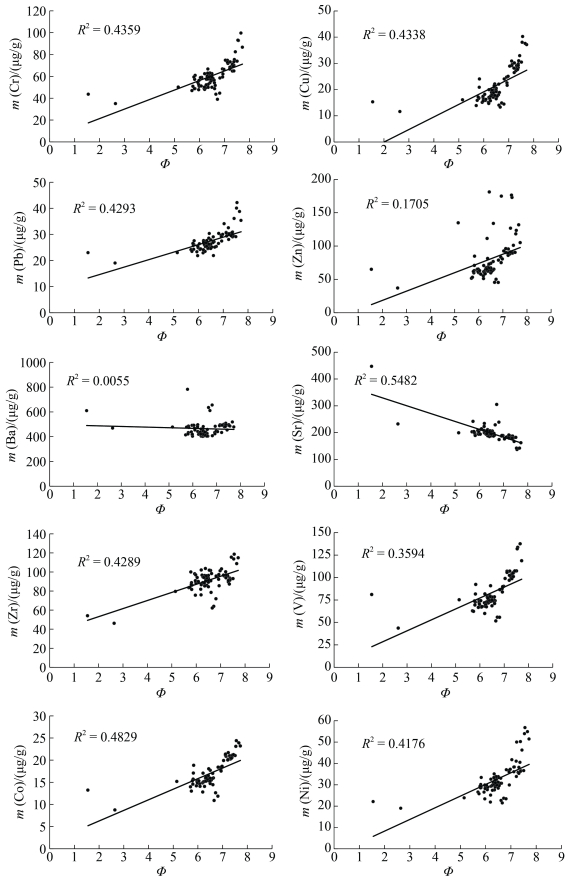 |
| 图 6 研究区表层沉积物微量元素含量与平均粒径相关性 Fig. 6 The correlation between the content of trace elements and mean size of the surface sediments in the study area |
用元素的平均含量来判别物源难以消除粒级效应的影响, 而元素的比值则可以作为可靠的识别标志, 不仅可以反映元素的富集或分散程度, 还将元素受粒级分布的影响降低[28]。陆源碎屑组分中Cr、V、Zr、Co等元素在表生环境中比较稳定, 一般被固体物质吸附, 随碎屑颗粒一同搬运沉积, 基本继承了源区的特征, 能够作为物源识别的有效指标[15, 25]。且根据研究区微量元素因子分析结果, 本区Ni、Cr、V元素主要来自陆源。因此选取表层沉积物微量元素中的m(Cr)/m(V)-m(Ni)的值进行投点(如图 7所示), 并和黄河、长江、韩国河流做对比。结果显示研究区的表层沉积物都以黄河来源为主, 与已有研究结果相同[15], 但Ⅰ区可能受到长江沉积物来源的影响, 研究区基本不受韩国河流的影响。
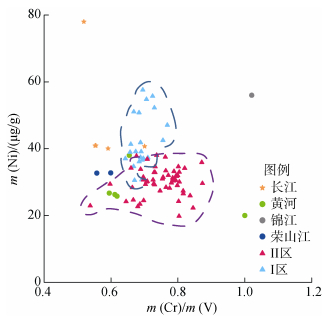 |
| 图 7 研究区m(Cr)/m(V)-m(Ni)物源判别图 Fig. 7 Provenance discrimination plot of m(Cr)/m(V)-m(Ni) in the study area |
结合因子分析和微量元素分区结果, 表明黄河携带大量泥沙入海后, 约70%的泥沙因河口区水动力条件改变在河口三角洲和浅海沉积, 其余的则在沿岸流和潮流的共同作用下进入黄海[16]。接着在黄海沿岸流的搬运下, 一部分黄河物质在山东半岛北部区域和北黄海中部泥质区沉积, 另一部分则随着黄海沿岸流绕过成山头向南黄海搬运。由于南黄海水动力条件复杂, 大部分在成山头附近水下台地快速沉积[39], 形成泥质楔, 剩下的继续向南搬运, 因此研究区主要物质来源为黄河物质。但在36.5°N附近, 向南的黄海沿岸流受到北上黄海暖流的阻隔[7], 便向西偏转并大量快速沉积, 同时黄海沿岸流和黄海暖流发生混合扩散, 使得向西偏转的黄海沿岸流夹杂了少量由黄海暖流携带来的南黄海物质, 因此, 在研究区南侧也受到了长江物质的影响, 但根据本文研究结果, 长江来源物质对本区影响很小而且比较有限。
4 结论1) 研究区表层沉积物各微量元素含量空间分布差异较大, 研究区Ba含量整体呈中间低、四周高的趋势; Sr整体呈近岸高、离岸低的分布特征; Cr、Cu、Ni、Pb、Co和V等微量元素含量空间分布特征基本一致, 整体呈近岸低、离岸高的分布特征。Sr的空间含量变化反映了黄河来源物质的搬运过程, Co的空间分布表明了研究区南部受到黄海暖流携带物质的影响。
2) 研究区表层沉积物微量元素含量相关性分析表明, 山东半岛东部海域表层沉积物中微量元素的分布受物源和粒度控制效应影响。根据研究区表层沉积物微量元素含量与平均粒径相关性散点图, 研究区微量元素除Ba、Sr外, 其余元素与平均粒径呈正相关, Sr元素则与平均粒径呈负相关性, Ba元素的粒级效应不明显。
3) 根据Q型聚类分析, 研究区可分为南、北两类沉积物。采用Cr/V-Ni散点图判别, 山东半岛东部近岸海域沉积物来源主要为黄河物质, 在研究区南侧可能有少量黄海暖流携带的长江物质输入。
| [1] |
陈志华, 石学法, 王相芹. 南黄海表层沉积物碳酸盐及Ca、Sr、Ba分布特征[J]. 海洋地质与第四纪地质, 2000, 20(4): 9-16. Chen Zhihua, Shi Xuefa, Wang Xiangqin. Distribution characteristics of carbonate as well as Ca, Sr and Ba in the surface sediments in the south Yellow Sea[J]. Marine Geology & Quaternary Geology, 2000, 20(4): 9-16. |
| [2] |
Yang S Y, Jung H S, Lim D I, et al. A review on the provenance discrimination of sediments in the Yellow Sea[J]. Earth Science Reviews, 2003, 63(1): 93-120. |
| [3] |
徐刚, 刘健, 孔祥淮, 等. 南黄海中部泥质沉积成因和物源研究综述[J]. 海洋地质动态, 2010, 26(2): 8-12. Xu Gang, Liu Jian, Kong Xianghuai, et al. Sedimentary origin provenance of the muddy deposition in the central South Yellow Sea[J]. Marine Geology Letters, 2010, 26(2): 8-12. DOI:10.3969/j.issn.1009-2722.2010.02.002 |
| [4] |
Milliman J D, Beardsley R C, Yang Z S, et al. Modern Huanghe-derived muds on the outer shelf of the East China Sea: identification and potential transport mechanisms[J]. Continental Shelf Research, 1985, 4(1-2): 175-188. DOI:10.1016/0278-4343(85)90028-7 |
| [5] |
Martin J M, Zhang J, Shi M C, et al. Actual flux of the Huanghe (Yellow River) sediment to the Western Pacific Ocean[J]. Netherlands Journal of Sea Research, 1993, 31(3): 243-254. DOI:10.1016/0077-7579(93)90025-N |
| [6] |
Yang Z S, Liu J P. A unique Yellow River-derived distal subaqueous delta in the Yellow Sea[J]. Marine Geology, 2007, 240(1-4): 169-176. DOI:10.1016/j.margeo.2007.02.008 |
| [7] |
李国刚, 胡邦琦, 李军, 等. 山东半岛沿岸海域表层沉积物的常量元素及其地质意义[J]. 海洋地质与第四纪地质, 2012, 32(3): 45-54. Li Guogang, Hu Bangqi, Li Jun, et al. Geochemistry of major elements in the surface sediments of the offshore area of Shandong Peninsula and its geological implications[J]. Marine Geology & Quaternary Geology, 2012, 32(3): 45-54. |
| [8] |
赵胜, 于非, 刁新源, 等. 黄海暖流的路径及机制研究[J]. 海洋科学, 2011, 35(11): 73-80. Zhao Sheng, Yu Fei, Diao Xinyuan, et al. The path and mechanism of the Yellow Sea Warm Current[J]. Marine Sciences, 2011, 35(11): 73-80. |
| [9] |
卢健, 李安春, 刘健. 南黄海表层沉积物粒度特征季节变化及其影响因素[J]. 海洋科学, 2015, 39(3): 48-58. Lu Jian, Li Anchun, Liu Jian. Seasonal variations and influencing factors of the grain size characteristics of surface sediments in the South Yellow Sea[J]. Marine Sciences, 2015, 39(3): 48-58. |
| [10] |
蓝先洪, 王红霞, 李日辉, 等. 南黄海沉积物常量元素组成及物源分析[J]. 地学前缘, 2007, 14(4): 197-203. Lan Xianhong, Wang Hongxia, Li Rihui, et al. Major elements composition and provenance analysis in the sediments of South Yellow Sea[J]. Earth Science Frontiers, 2007, 14(4): 197-203. DOI:10.3321/j.issn:1005-2321.2007.04.021 |
| [11] |
蓝先洪, 王红霞, 张志珣, 等. 南黄海表层沉积物稀土元素分布与物源关系[J]. 中国稀土学报, 2006, 24(6): 745-749. Lan Xianhong, Wang Hongxia, Zhang Zhixun, et al. Distributions of rare earth elements and provenance relations in the surface sediments of the South Yellow Sea[J]. Journal of the Chinese Rare Earth Society, 2006, 24(6): 745-749. DOI:10.3321/j.issn:1000-4343.2006.06.020 |
| [12] |
蓝先洪, 张志珣, 李日辉, 等. 南黄海表层沉积物微量元素地球化学特征[J]. 海洋地质与第四纪地质, 2006, 26(3): 45-51. Lan Xianhong, Zhang Zhixun, Li Rihui, et al. Geochemistry characteristics of trace elements in the surface sediments of the south Yellow Sea[J]. Marine Geology & Quaternary Geology, 2006, 26(3): 45-51. |
| [13] |
Lim D I, Jung H S, Choi J Y, et al. Geochemical compositions of river and shelf sediments in the Yellow Sea: Grain-size normalization and sediment provenance[J]. Continental Shelf Research, 2006, 26(1): 15-24. DOI:10.1016/j.csr.2005.10.001 |
| [14] |
Yang S, Youn J S. Geochemical compositions and provenance discrimination of the central south Yellow Sea sediments[J]. Marine Geology, 2007, 243(1): 229-241. |
| [15] |
窦衍光, 李军, 杨守业. 山东半岛东部海域表层沉积物元素组成及物源指示意义[J]. 海洋学报, 2012, 34(1): 109-119. Dou Yanguang, Li Jun, Yang Shouye. Element compositions and provenance implication of surface sediments in offshore areas of the eastern Shandong Peninsula in China[J]. Acta Oceanologica Sinica, 2012, 34(1): 109-119. |
| [16] |
蓝先洪, 张训华, 张志珣. 南黄海沉积物的物质来源及运移研究[J]. 海洋湖沼通报, 2005(4): 53-60. Lan Xianhong, Zhang Xunhua, Zhang Zhixun. Material sources and transportation of sediments in the southern Yellow Sea[J]. Transactions of Oceanology and Limnology, 2005(4): 53-60. DOI:10.3969/j.issn.1003-6482.2005.04.008 |
| [17] |
李军, 胡邦琦, 李国刚, 等. 山东半岛近海不同粉砂粒级含量分布的空间差异性及其沉积学意义[J]. 海洋学报, 2017, 39(1): 64-75. Li Jun, Hu Bangqi, Li Guogang, et al. Spatial variability of different silt components and its sedimentary significance offshore Shandong Peninsula[J]. Acta Oceanologica Sinica, 2017, 39(1): 64-75. DOI:10.3969/j.issn.0253-4193.2017.01.007 |
| [18] |
蓝先洪, 李日辉, 密蓓蓓, 等. 渤海东部和黄海北部表层沉积物稀土元素的分布特征与物源判别[J]. 地球科学, 2016, 41(3): 463-474. Lan Xianhong, Li Rihui, Mi Beibei, et al. Distribution characteristics of rare earth elements in surface sediment and their provenance discrimination in the Eastern Bohai and Northern Yellow Seas[J]. Earth Science, 2016, 41(3): 463-474. |
| [19] |
蓝先洪, 李日辉, 张志珣, 等. 渤海东部与黄海北部表层沉积物的元素地球化学记录[J]. 地球学报, 2015, 36(6): 718-728. Lan Xianhong, Li Rihui, Zhang Zhixun, et al. Element geochemistry records of surface sediments in the East of the Bohai Sea and the Northern Yellow Sea[J]. Acta Geoscientica Sinica, 2015, 36(6): 718-728. |
| [20] |
艾丽娜, 韩宗珠, 王双, 等. 渤黄海表层沉积物黏土矿物组成及分布特征对物源的指示意义[J]. 海洋湖沼通报, 2016(5): 60-68. Ai Lina, Han Zhongzhu, Wang Shuang, et al. Composition and distribution of clay minerals in surface sediments of the Bohai Sea and the Yellow Sea and their implications to provenance[J]. Transactions of Oceanology and Limnology, 2016(5): 60-68. |
| [21] |
张晓东, 季阳, 杨作升, 等. 南黄海表层沉积物粒度端元反演及其对沉积动力环境的指示意义[J]. 中国科学:地球科学, 2015, 45(10): 1515-1523. Zhang Xiaodong, Ji Yang, Yang Zuosheng, et al. End member inversion of surface sediment grain size in the South Yellow Sea and its implications for dynamic sedimentary environments[J]. Science China: Earth Sciences, 2015, 45(10): 1515-1523. |
| [22] |
张剑, 李日辉, 王中波, 等. 渤海东部与黄海北部表层沉积物的粒度特征及其沉积环境[J]. 海洋地质与第四纪地质, 2016, 36(5): 1-12. Zhang Jian, Li Rihui, Wang Zhongbo, et al. Grain size characteristics of surface sediments in the east Bohai Sea and the northern Yellow Sea and their implications for environments[J]. Marine Geology & Quaternary Geology, 2016, 36(5): 1-12. |
| [23] |
刘健, 李绍全, 王圣洁, 等. 末次冰消期以来黄海海平面变化与黄海暖流的形成[J]. 海洋地质与第四纪地质, 1999, 19(1): 13-24. Liu Jian, Li Shaoquan, Wang Shengjie, et al. Sea level changes of the Yellow Sea and formation of the Yellow Sea warm current since the last deglaciation[J]. Marine Geology & Quaternary Geology, 1999, 19(1): 13-24. |
| [24] |
Kim G, Yang H S, Church T M. Geochemistry of alkaline earth elements (Mg, Ca, Sr, Ba) in the surface sediments of the Yellow Sea[J]. Chemical Geology, 1999, 153(1): 1-10. |
| [25] |
杨守业, 李从先, JungHoi-soo, 等. 中韩河流沉积物微量元素地球化学研究[J]. 海洋地质与第四纪地质, 2003, 23(2): 19-24. Yang Shouye, Li Congxian, Jung Hoi-soo, et al. Geochemistry of trace elements in Chinese and Korean River sediments[J]. Marine Geology & Quaternary Geology, 2003, 23(2): 19-24. |
| [26] |
Li Y H, Teraoka H, Yang T S, et al. The elemental composition of suspended particles from the Yellow and Yangtze Rivers[J]. Geochimica et Cosmochimica Acta, 1984, 48(7): 1561-1564. DOI:10.1016/0016-7037(84)90411-3 |
| [27] |
Yang Shouye, Li Congxian. Elemental composition in the sediments of the Yangtze and the Yellow Rivers and their tracing implication[J]. Progress in Natural Science: Materials International, 2000, 10(8): 616-618. |
| [28] |
杨守业, 李从先. 长江与黄河现代表层沉积物元素组成及其示踪作用[J]. 自然科学进展:国家重点实验室通讯, 1999, 9(10): 930-937. Yang Shouye, Li Congxian. The composition and tracer role of the sediments in the present representative layer of the Yangtze River and the Yellow River[J]. Progress in Natural Science: State Key Laboratory Communication, 1999, 9(10): 930-937. |
| [29] |
杨守业, 李从先. 长江与黄河沉积物元素组成及地质背景[J]. 海洋地质与第四纪地质, 1999, 19(2): 19-26. Yang Shouye, Li Congxian. Characteristic element compositions of the Yangtze and the Yellow River sediments and their geological background[J]. Marine Geology & Quaternary Geology, 1999, 19(2): 19-26. |
| [30] |
赵一阳. 中国浅海沉积物地球化学[M]. 北京: 科学出版社, 1994: 1-105. Zhao Yiyang. Geochemistry of Sediments of the China Shelf Sea[M]. Beijing: Science Press, 1994: 1-105. |
| [31] |
Choi M S. Element geochemistry of suspendedsediments in Korean Rivers: Han, Keum, Mangyeong, Yeongsan, Seomjin and Nakdong Rivers[C]//Cho Y G. Proceedings of the 5th International Symposium on the Marine Science of the Yellow Sea, Inchon, Korea. Seoul: Inha University, 2001: 338-341.
|
| [32] |
石学法, 申顺喜, YiHi-il, 等. 南黄海现代沉积环境及动力沉积体系[J]. 科学通报, 2001, 46(s1): 1. Shi Xuefa, Shen Shunxi, Yi Hi-il, et al. Modern sedimentary environments and dynamic depositional system in the Southern Yellow Sea[J]. Chinese Science Bulletin, 2001, 46(s1): 1. |
| [33] |
王飞飞, 刘健, 仇建东, 等. 南黄海中西部全新世中期以来泥质沉积厚度与成因[J]. 海洋地质与第四纪地质, 2014, 34(5): 1-11. Wang Feifei, Liu Jian, Qiu Jiandong, et al. Thickness variation and provenance of mid-Holocene mud sediments in the central and western south Yellow Sea[J]. Marine Geology & Quaternary Geology, 2014, 34(5): 1-11. |
| [34] |
程鹏, 高抒. 北黄海西部海底沉积物的粒度特征和净输运趋势[J]. 海洋与湖沼, 2000, 31(6): 604-615. Cheng Peng, Gao Shu. Net sediment transport patterns over the northwestern Yellow Sea, based upon grain size trend analysis[J]. Oceanologia et Limnologia Sinica, 2000, 31(6): 604-615. DOI:10.3321/j.issn:0029-814X.2000.06.004 |
| [35] |
Cullers R L. The controls on the major and trace element variation of shales, siltstones and sandstones of Pennsylvanian-Permian age from uplifted continental blocks in Colorado to platform sediment in Kansas, USA. GeochimCosmochimActa[J]. Geochimica et Cosmochimica Acta, 1994, 58(22): 4955-4972. DOI:10.1016/0016-7037(94)90224-0 |
| [36] |
Nesbitt H W, Markovics G. Weathering of granodioritic crust, long-term storage of elements in weathering profiles, and petrogenesis of siliciclasticsediments[J]. Geochimica et Cosmochimica Acta, 1997, 61(8): 1653-1670. DOI:10.1016/S0016-7037(97)00031-8 |
| [37] |
金秉福, 林振宏, 季福武. 海洋沉积环境和物源的元素地球化学记录释读[J]. 海洋科学进展, 2003, 21(1): 99-106. Jin Bingfu, Lin Zhenhong, Ji Fuwu. Interpretation of element geochemical records of marine sedimentary environment and provenance[J]. Advances in Marine Science, 2003, 21(1): 99-106. DOI:10.3969/j.issn.1671-6647.2003.01.013 |
| [38] |
朱赖民, 高志友, 尹观, 等. 南海表层沉积物的稀土和微量元素的丰度及其空间变化[J]. 岩石学报, 2007, 23(11): 2963-2980. Zhu Laimin, Gao Zhiyou, Yin Guan, et al. Content and spatial change of rare earth element and trace element of surficial sediment in the South China Sea[J]. Acta Petrologica Sinica, 2007, 23(11): 2963-2980. DOI:10.3969/j.issn.1000-0569.2007.11.027 |
| [39] |
孔祥淮, 刘健, 李巍然, 等. 山东半岛东北部滨浅海区表层沉积物粒度及矿物成分[J]. 海洋地质与第四纪地质, 2006, 26(3): 21-29. Kong Xianghuai, Liu Jian, Li Weiran, et al. Grain-size characters and mineral components of surface sediments in the offfshore area of northeastern Shandong Peninsula[J]. Marine Geology & Quaternary Geology, 2006, 26(3): 21-29. |
 2018, Vol. 42
2018, Vol. 42

